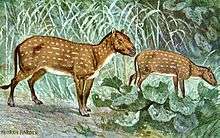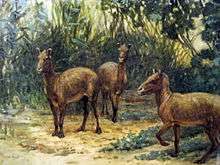Eohippus
| Eohippus Temporal range: Ypresian | |
|---|---|
| | |
| National Museum of Natural History, Washington, D.C. | |
| Scientific classification | |
| Kingdom: | Animalia |
| Phylum: | Chordata |
| Class: | Mammalia |
| Order: | Perissodactyla |
| Family: | Equidae |
| Genus: | †Eohippus (Marsh, 1876) |
| Binomial name | |
| †E. angustidens (Cope, 1875) | |
| Synonyms | |
| |
Eohippus is an extinct genus of small equid ungulates.[1] The only species is E. angustidens, which was long considered a species of Hyracotherium. Its remains have been identified in North America and date to the Early Eocene (Ypresian) stage.[2]
Discovery


In 1876, Othniel C. Marsh described a skeleton as Eohippus validus, from the Greek ηώς (eōs, "dawn") and ιππος (hippos, "horse"), meaning "dawn horse". Its similarities with fossils described by Richard Owen were formally pointed out in a 1932 paper by Sir Clive Forster Cooper. E. validus was moved to the genus Hyracotherium, which had priority as the name for the genus, with Eohippus becoming a junior synonym of that genus. Hyracotherium was recently found to be a paraphyletic group of species, and the genus now includes only H. leporinum. E. validus was found to be identical to an earlier-named species, Hyracotherium angustidens (Cope, 1875), and the resulting binomial is thus Eohippus angustidens.
Common misconception on size
In elementary-level textbooks, Eohippus is only described as being "the size of a small Fox Terrier", despite the Fox Terrier being about half the size of Eohippus. This arcane analogy was so curious that Stephen Jay Gould wrote an essay about it ("The Case of the Creeping Fox Terrier Clone", essay #10 in his book, Bully for Brontosaurus), in which he concluded that Henry Fairfield Osborn had so described it in a widely distributed pamphlet. The reasons for this comparison are unclear, but Gould posits that Osborn, a keen fox hunter, could have made a natural association between horses and the dogs that accompany them.[3]
References
- ↑ MacFadden, B. J. (March 18, 2005). "Fossil Horses--Evidence for Evolution". Science. 307 (5716): 1728–1730. doi:10.1126/science.1105458. PMID 15774746.
- ↑ Froehlich, D. J. (2002). "Quo vadis eohippus? The systematics and taxonomy of the early Eocene equids (Perissodactyla)". Zoological Journal of the Linnean Society. 134 (2): 141–256. doi:10.1046/j.1096-3642.2002.00005.x.
- ↑ Gould, S.J. (1991). Bully for Brontosaurus: Reflections in Natural History, W. W. Norton & Co., 540pp.